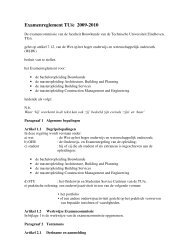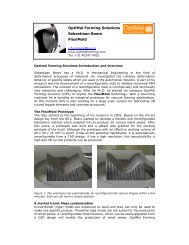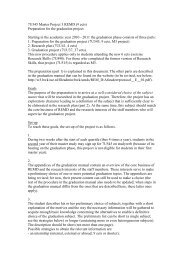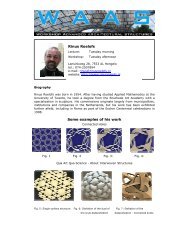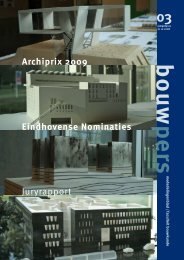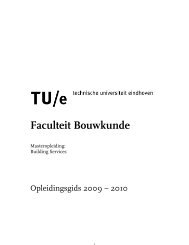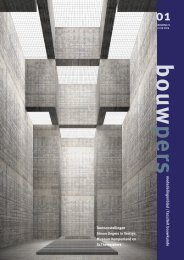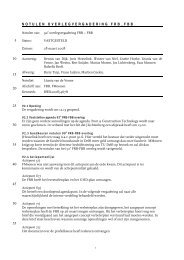afst.bundel 8 MEI 07 - Technische Universiteit Eindhoven
afst.bundel 8 MEI 07 - Technische Universiteit Eindhoven
afst.bundel 8 MEI 07 - Technische Universiteit Eindhoven
Create successful ePaper yourself
Turn your PDF publications into a flip-book with our unique Google optimized e-Paper software.
<strong>afst</strong>udeer<strong>bundel</strong> faculteit bouwkunde<br />
58<br />
J.H. van Zanten<br />
The influence of a non-uniform<br />
building cross-section on its<br />
structural behaviour<br />
An analytical verification method of numerical studies<br />
Afstudeerrichting<br />
Structural design<br />
Afstudeercommissie<br />
Dr. Ir. M.C.M. Bakker<br />
Dr. Ir. J.C.D. Hoenderkamp<br />
Prof. Ir. H.H. Snijder<br />
Datum <strong>afst</strong>uderen<br />
29 januari 2008<br />
Samenvatting<br />
In dit project heb ik geprobeerd om een eenvoudige handberekeningsmethode<br />
op te stellen, waarmee men een complexe<br />
hoogbouw constructie kan dimensioneren en ontwerpen in het<br />
beginstadium van een project. Hierbij heb ik met name de<br />
nadruk gelegd op een mogelijke verandering in plattegrond van<br />
het gebouw. Ik heb geprobeerd om een benaderingsmethode te<br />
ontwikkelen, waarmee in een vroeg stadium de horizontale verplaatsingen<br />
van zo’n gebouw kunnen worden bepaald met relatief<br />
eenvoudige handberekeningen. Deze berekeningen kunnen<br />
in een later stadium gebruikt worden om de complexe eindige<br />
elementen modellen te toetsen.<br />
Trefwoorden<br />
Shear<br />
High-rise<br />
Analytical<br />
Deflection<br />
Bending<br />
Problem, Goal<br />
This project is a derivative of the problems involved in verifying<br />
the finite element method models of complex structures.<br />
The goal for this project was to design a simple hand calculation<br />
method to analyse the deflections of a complex high-rise<br />
structure with shifts in the neutral axes of the structure.<br />
Approach<br />
The original structure consists of eight storeys, each with a<br />
different cross-section. This structure is simplified by making a<br />
finite element method model with only three different crosssections,<br />
each three storeys high. Complicating factors of the<br />
design are, among others, the shifts in neutral axes of the<br />
structure, the misalignment of the shear centre en centroid of<br />
the middle cross-section, the discrete character of the structure,<br />
and the torsional moments on the structure due to wind<br />
loading. In this research, the structure is examined, subjected to<br />
a point load and a torsional moment at the top of the structure.<br />
The structure is approximated by means of an “equivalent<br />
non-uniform column”. However, in order to be able to<br />
investigate this non-uniform structure, first three uniform<br />
structures are examined, that later combine to form the nonuniform<br />
structure. These uniform structures are examined with<br />
“equivalent uniform columns”.<br />
The properties of the individual cross-sections are implemented<br />
in the non-uniform column.<br />
All cross-sections are examined for shear, bending and torsional<br />
deflections, where the top cross-section is rotated compared to<br />
the other two cross-sections, so this cross-section is subject to<br />
“double bending”.<br />
Boundary conditions<br />
A number of boundary conditions are used to enable the<br />
comparison of the 3D truss structures to the equivalent<br />
columns. For example, the top floors of the uniform structures<br />
are not only infinitely stiff in plane, but also infinitely stiff out of<br />
plane. This is also the case for the floors at the connecting levels<br />
of the non-uniform structure. This ensures that plain sections<br />
remain plane, which is a boundary condition necessary for<br />
applying Steiners theorem. This theorem is at the basis of the<br />
equivalent column theory, so it must be applied in order to<br />
compare the two types of structures. Another condition that<br />
must be met is that all connections of all elements in the truss<br />
must be hinged connections. The analysis itself is linear<br />
elastic only, and finally, warping for the middle cross-section is<br />
not taken into account. This is accomplished by transforming<br />
the middle cross-section into a “Neuber tube”. This ensures that<br />
no warping occurs, only pure torsion. The difference between<br />
the “Neuber tube” of the middle cross-section, and the original<br />
middle cross-section is assumed to account for the warping<br />
stiffness. This assumption is still subject to debate, and requires<br />
further research in order to be shown valid.<br />
Results<br />
If the results of the uniform and non-uniform structures are<br />
compared with the hand calculations and the equivalent<br />
columns, the shear deflections are found to correlate completely.<br />
Between the results of the bending deflections the differences<br />
are minimal (the maximum difference is less than 2%), and the<br />
torsional deflections correlate exactly as well.<br />
All of these differences are within the boundaries set in the goal<br />
for this project (maximum difference of 5%), and furthermore,<br />
the differences can be explained. The most important reasons<br />
for the differences between the different models are the<br />
discretization errors. For a nine storey uniform structure, the<br />
discretization error can be computed to be 0.309%.<br />
This matches the differences found for the uniform structures.<br />
For the non-uniform structures the discretization error is larger,<br />
but the deformations are all within the goals set for this project.<br />
Due to the positioning of the equivalent columns (in the shear<br />
centres) the Z-deflections of the equivalent non-uniform column<br />
deviate from the Z-deflection of the simplified non-uniform<br />
structure. The X- and Y-deflections however correlate completely.<br />
This is expected, and it is suggested that accurate X- and Y-<br />
deflections are more important.



